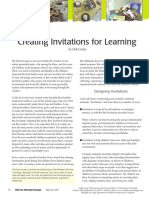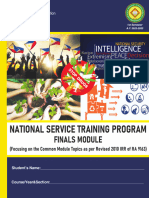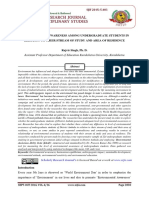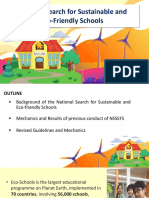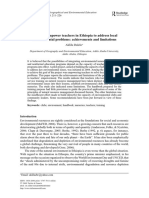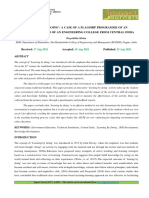David Sobel - Look Dont Touch
David Sobel - Look Dont Touch
Uploaded by
danieladanuCopyright:
Available Formats
David Sobel - Look Dont Touch
David Sobel - Look Dont Touch
Uploaded by
danieladanuCopyright
Available Formats
Share this document
Did you find this document useful?
Is this content inappropriate?
Copyright:
Available Formats
David Sobel - Look Dont Touch
David Sobel - Look Dont Touch
Uploaded by
danieladanuCopyright:
Available Formats
Look, Dont Touch
The problem with environmental education
BY DAVID SOBEL Published in the July/August 2012 issue of Orion magazine
THE KIDS HAVE BEEN UP since seven-thirty playing computer games and watching cartoons. What a travesty for them to be inside on such a beautiful day, you harrumph to yourself. On the refrigerator, you notice the schedule of events from the nearby nature center. Lets Get Face to Face with Flowers, it beckons. Just the thing!Its a sparkly May morning. Buds are bursting. Theres a warm breeze full of the aromatic scent of the woods just waking up. You trundle the kids into the minivan. They despondently consent. Do we have to do a program? Programs are boring, the older one complains. But as soon as you pull into the parking lot at Happy Hills Nature Center, their faces brighten. They fling the sliding door open and scamper down through the blossom-filled meadow to the shore of the pond. Ross, age seven, pulls off his sneakers and wades in, bent over searching for frogs. Amanda, age ten, plops down and starts making a dandelion tiara. What a good decision, you think to yourself. Terri, the smiley naturalist wearing the official Happy Hills insigniaed st aff shirt, saunters over. Here for the flower program? she chirps. Were meeting up in the Cozy Corner room to get started. Ross asks, Can Freddie come too? holding up the fat green frog he has befriended. Terris bright face darkens a bit. Sorry. Freddie needs to stay in the pond. Did you know the oils from your hands can make Freddie sick? In the darkened Cozy Corner room, Terri has prepared a PowerPoint of all the flowers you might see on the trail today. Here are some spring beauties. They look just like little peppermint candies. But, of course, we cant eat them. And heres one of my favorites, Dutchmans breeches. Why do you think we call them that? After about the seventh slide the kids start to squirm in their seats. Daddy, I have to go pee, complains Ross. After about the twenty-seventh slide, you too have to go pee. And now, lets see how many we can find, Terri says. Its good to be back outside. Upon entering the woods, Amanda notices a red eft in a patch of moss. She takes a few steps off the trail and Terri chastises her: Remember, Amanda, nature is fragile! When you walk off the trail, you crush all kinds of little creatures you cant see. Farther on Ross scampers up into the inviting branches of a tree that has fallen
across the trail. Sorry, Ross, no climbing, too dangerous, we wouldnt want you to get hurt. At each flower, Terri circles everyone around and tells them the Latin name, the herbal uses, the pollinator, the . . . Once in a while someone gets to touch the petals, only veeerrry gently. Picking flowers is strictly verboten. Toward the end of the walk, the trail comes out by the pond, where Amanda finds her discarded dandelion tiara and slips it into her shirt, watching to make sure Terri doesnt notice. On the ride home, no one talks. Well, that was fun, you enthuse, trying to get the conversation going. Amanda extracts her dandelion tiara and perches it on her head. Picking flowers was fun. But we told you about programs, Daddy. Too many rules. It wouldve been fun if we could have just played all together in the meadow. You find that you agree. Contrast this experience with John Muirs recollection of arriving at his familys first American homestead in remote Fountain Lake, Wisconsin, when he was eleven. Within minutes, he and his brother were up in a tree observing a blue jays nest. From there they raced about to find a bluebirds nest, then a woodpeckers, and thus began an acquaintance with the frogs and snakes and turtles in the creeks and springs. The new world of untamed America was thrilling for John and his brother: The sudden plash into pure wildnessbaptism in Natures warm hearthow utterly happy it made us! Nature streaming into us, wooingly teaching her wonderful glowing lessons, so unlike the dismal grammar ashes and cinders so long thrashed into us. . . . Young hearts, young leaves, flowers, animals, the winds and the streams and the sparkling lake, all wildly, gladly rejoicing together! This is the joy of children encountering the natural world on their own terms, and more and more it is becoming a lost idyll, no longer an integral part of growing up. There are many reasons for this loss urbanization, the changing social structure of families, ticks and mosquito-borne illnesses, the fear of stranger danger. And perhaps even environmental education is one of the causes of childre ns alienation from nature. I know thats a puzzling statement. Youre thinking: environmental education is supposed to connect children with nature, to get them started on a lifetime of loving and wanting to protect the natural world. Yesthats what is supposed to happen. But somewhere along the way, much of environmental education lost its magic, its wildly, gladly rejoicing together. Instead, its become didactic and staid, restrictive and rule bound. A creeping focus on cognition has replaced the goal of exhilaration that once motivated educators to take children outside. Much of environmental education today has taken on a museum mentality, where nature is a composed exhibit on the other side of the glass. Children can look at it and study it, but th ey cant do anything with
it. The message is: Nature is fragile. Look, but dont touch. Ironically, this take only photographs, leave only footprints mindset crops up in the policies and programs of many organizations trying to preserve the natural world and cultivate childrens relationships to it. IF YOU WALK THE DRIFTWOOD-CLUTTERED shores along Maines crenulated coast, youll find a number of ramshackle constructions in the coves. KIDS FORT! NO ADULTS ALLOWED! a hand -lettered sign will warn. The forts are woven into the spruce blowdown at the edge of the shore, or crouched between the top of the beach cobble and the steep, blackberried bank. Planks, lobster pots, buoys, scrap metal, broken ladders, discarded tarps are pieced together to create bedrooms, lookouts, kitchens, storage cabinets. It is clear that deep, unadulterated play is alive in these salty edges beyond the purview of parents. And yet, on many land trust properties on the coast of Maine, fort building is outlawed because of concerns over liability and unsightliness. I believe that the imaginative, constructive practice of fort building actually fosters the sense of connectedness that land trusts want to cultivate in young people. Its an instinctive drive to make a home in the world away from the home your parents provided you. When you make a fort, or den, or hideout, it creates a connection to the land, nurturing an affinity for that place. Discouraging these natural tendencies of childhood could actually lead to resentment of, and a lack of commitment to, the land trusts agenda of land preservation. When I wrote an op-ed piece for the Bangor Daily News articulating this conviction, one Maine land trust board member responded, Realistically, if the land trust allowed some fort-building along the shore, then how much is too much? Following typical monkey-see monkey-do behavior, if one fort is built, then other people come along and decide to build a second fort, and so it goes. Then weve got a neighborhood of forts that has become a distraction and an eyesore to those who want to teach kids to appreciate nature using a light-handed approach. The scale of fairy house construction on another coastal island is testimony to the scourge this can become. See what I mean? Head south to Texas and youll encounter more of the same. At the Lady Bird Johnson Wildflower Center in Austin, the trails ramble through hill country chapparalhardy shrubs, some cactus, copses of woods. Its an unfragile, wonderfully explorable landscape. When I asked if child ren were allowed to go off the trails, to play in the little pockets of woods, the education director looked at me disapprovingly. Oh no, we cant let children do that. The intimation was that this was way too dangerous for the children and would have too much impact on the natural resource. I wasnt convinced that either of these concerns was well founded or based on data. Its true in the inner city as well. When a friend of mine was the education director at the Arnold Arboretum in Boston, she was trying to create programs that encouraged the multiethnic children who lived in the neighborhood to develop a love for trees. When I asked, Well, do you let children climb any
of the trees? I got the same disapproving look from her. Tree climbing? Just not p ossible. Sure, I agree that the rare trees in the arboretum should be off-limits, but the big spreading native maples and beeches, the hemlocks down along the streamwhy not? Children have been climbing trees for millennia; its great exercise, and in the vast majority of cases, they dont get hurt. Keep in mind that children get hurt from falls in the bathtub, and we dont prohibit showers. Similarly, children get injured playing competitive sports. We tolerate the risk of injury from field hockey and soccer because we value the physical and social benefits. Why dont we have the same risk/benefit mindset in relation to climbing trees? Between the ages of six and twelve, children have an innate desire to explore the woods, build forts, make potions from wild berries, dig to China, and each of these activities is an organic, natural way for them to develop environmental values and behaviors. Instead, the look but dont touch approach cuts kids off from nature, teaching them that nature is boring and fraught with danger. Inadvertently, these messages send children back inside to the dynamic interactivity of computer games. Could it be that our fear of litigation and our puritanical concerns for protecting each and every blade of grass are hampering the development of the very stewardship values and behaviors that we environmental educators all say were trying to foster? I believe so. As a child in his native Scotland, John Muir vigorously embraced the natural world, having described himself as a devout martyr of wildnessa wild child. He was also a courageous inventor. We made guns out of gas-pipe, mounted them on sticks of any shape, clubbed our pennies together for powder, gleaned pieces of lead here and there and cut them into slugs, and, while one aimed, another applied a match to the touch-hole. With these awful weapons we wandered along the beach and fired at the gulls and solan-geese as they passed us. Fortunately we never hurt any of them that we knew of. We also dug holes in the ground, put in a handful or two of powder, tamped it well around a fuse made of a wheat-stalk, and, reaching cautiously forward, touched a match to the straw. This we called making earthquakes. Oftentimes we went home with singed hair and faces well peppered with powder-grains that could not be washed out. This is probably not the kind of boy youd want your children out roaming the neighborhood with. Dangerous, unmannered, destructive perhaps. Certainly, youve never seen an Inventing Guns and Shooting Sea Gulls program on Saturday mornings at the nature center. And yet John Muir helped create the national park system, and his writing has fostered environmental values and behaviors in countless millions of people. My contention is that John Muirs preservationist instincts gr ew in part out of these childhood experiences, which probably contributed more to his commitment to the natural world than learning the difference between sedimentary, metamorphic, and igneous rocks in the mandated third grade curriculum.
Or consider how Harvard entomologist and biodiversity advocate E. O. Wilson describes some of his early formative experiences in nature: I hunted reptiles: stunned and captured five-lined skinks with a slingshot, and learned the correct maneuver for catching Carolina anole lizards (approach, let them scuttle to the other side of the tree trunk and out of sight, peek to see where they are sitting, then take them by grabbing blind with one hand around the trunk). One late afternoon I brought home a coachwhip snake nearly as long as I was tall and walked into the house with it wrapped around my neck. Wilson, Muir, Rachel Carson, and Aldo Leopold all had such down-and-dirty experiences in childhood. Wilson didnt just look at butterflies, he collected them. He didnt take only p hotographs and leave only footprints, he caught ants and put them in jars to observe them. He was a collector, not a photographer, and he was allowed to indulge his curiosity without the scolding finger of an interfering adult. Generalizing from his own biographic experience, he summarizes, Hands-on experience at the critical time, not systematic knowledge, is what counts in the making of a naturalist. Better to be an untutored savage for a while, not to know the names or anatomical detail. Better to spend long stretches of time just searching and dreaming. Herein lie my two main points. First, environmental educators need to allow children to be untutored savages for a while. Nature programs should invite children to make mud pies, climb trees, catch fr ogs, paint their faces with charcoal, get their hands dirty and their feet wet. They should be allowed to go off the trail and have fun. Second, environmental educators need to focus way more on hands-on experience with children and way less on systematic knowledge. Or at least understand that systematic knowledge can emerge organically from lots of hands-on experience. Between the ages of six and twelve, learning about nature is less important than simply getting children out into nature. Terri, the Happy Hills naturalist, could have started the flower program right there in the meadow, having everyone make dandelion chains. (Call it Removing Invasives if you must.) She could have chosen three flowers to focus on that morning and challenged the children to learn to identify them blindfolded, by scent only. She might have had the children crawl through the meadow to see flowers at woodchuck level or given them dead bees on probes and challenged them to collect pollen from flowers with different structures. Out of these wild experiences, some systematic knowledge would have emerged. And Amanda and Ross might have said, Wow, I never knew flowers were so cool! THINGS STARTED OUT DIFFERENTLY for environmental education. The summer camp movement, one of the precursors of nature and environmental education, emerged at the turn of the twentieth century and was founded on the principle of embracing the vigorous outdoors life. One of its proponents, Dr. Eugene Swan, was the founder of Pine Island Camp, a preeminent Maine camp for boys. He wrote, It will do you more good . . . to sleep under boughs aslant, by a mountain lake with the trout broiling, than to see the Congressional Library or Niagara Falls. And he believed that the heeding of Natures ever -calling voice,
and an adaptation of our lives to her laws, is going to become a salvation of the American race. Swan advocated for the character-forming benefits of early morning plunges in the lake, living off the land, sleeping under the stars, midnight rituals, and complex fantastical games. He considered his camp to be the village of Boyville, where campers could be swept up by the great adventure into the magic land of boyhood. Similar adventures in Girlville soon followed. He and his camp directors created the War Game, the Whitehead Game, and a raft of other large, complex landscape games that take place over hours or days and challenge boys to run long distances in the woods, creep secretively, detect subtle clues, endure swarms of mosquitos, behave valiantly and heroically. Campers were immersed in, at one with, and consumed by nature. They forded rivers, ate fish they caught and berries they collected, tromped through swamps, climbed trees, constructed forts, followed tracks, captured snakes, did all the things that John Muir, Rachel Carson, Aldo Leopold, and most of the other great naturalists did in their childhoods. The Boy and Girl Scouts movments emerged not long after. The emphasis here was on primitive living skillscamping in the wilderness, building fires, making bows and arrows, preparing hides, tracking animals. In their original forms, these movements honored the deep inner desire in middle childhood to be self-sufficient, to learn how to survive with nothing but a jackknife and some strands of rawhide. The persistent popularity even today of Jean Craighead Georges bookssuch as My Side of the Mountain and Julie of the Wolves suggests that these instincts still persist. The rage over Suzanne Collinss The Hunger Games springs forth from this same deep well. These desires are encoded in our genes, compelling children to connect with their wild selves. From the summer camp and Scouting roots, the environmental education movement emerged in the late 60s and 70s. It started out as nature education, but with all the bad news about rainforest destruction, the ozone hole, and toxics in the environment, it soon became dominated by a desire to recruit children to fix all these problems. The tendency to push things down onto developmentally unsuspecting young children, like the pressure to learn to read in kindergarten, led to the creation of a generation of children fearful of the death of the planet at the hands of uncaring humans. A UNESCO definition from the late 70s says that environmental education . . . should prepare the individual for life through an understanding of the major problems [emphasis mine] of the contemporary world, and the provision of skills and attributes needed to play a productive role towards improving life and protecting the environment. Meanwhile, in formal educational spheres, environmental education wanted to play with the big boys. It wanted to be more like reading and math and science, wanted to be more incorporated into the academic standards. As a result, environmental education got reduced to a set of facts to be mastered, content to be internalized and regurgitated. In the efforts to gain legitimacy and solve pressing problems, all the joy was sucked out of environmental education.
THE BIG QUESTION IS: whats the most effective way to parent and educate children so that they will grow up to behave in environmentally responsible ways? Or, more specifically, what kinds of learning, or what kinds of experience, will most likely shape young adults who want to protect the environment, serve on conservation commissions, think about the implications of their consumer decisions, and minimize the environmental footprints of their personal lives and the organizations where they work? Interestingly, theres an emergent body of research thats starting to clarify the relationship between childhood experience and adult stewardship behavior. First, a number of researchers surveyed environmentalists to determine if there were any similarities in their childhood experiences that might have led to their having strong ecological values or their choice of an environmental career. When Louise Chawla of the University of Colorado reviewed these studies, she found a striking pattern. Most environmentalists attributed their commitment to a combination of two sources, many hours spent outdoors in a keenly remembered wild or semi-wild place in childhood or adolescence, and an adult who taught respect for nature. Involvement with organizations like Scouts or environmental clubs was cited by significantly fewer of the respondents. Chawla found that
environmentalists talk about free play and exploration in nature, and family members who focused their attention on plants or animal behavior. They dont talk much about formal education and informal na ture education. Only in late childhood and adolescence do summer camp, teachers, and environmental clubs start to show up as being contributors to the individuals environmental values and behaviors. It seems that allowing children to be untutored savages early on can lead to environmental knowledge in due time. Some researchers then said: Well, lets not only look at environmentalists. How about the general public, Joe the plumber? What affects whether they develop environmental attitudes and behaviors? Nancy Wells and Kristi Lekies from Cornell University took on this question, and described their findings in Nature and the Life Course: Pathways from Childhood Nature Experiences to Adult Environmentalism. The study is based on interviews with two thousand adults (plumbers, teachers, accountants, nurses, policemen) ranging in age from eighteen to ninety, chosen randomly from more than one hundred urban areas around the country. The researchers compared three kinds of childhood nature experience wild nature experience, domesticated nature experience, and environmental education. They found that Childhood participation in wild nature, such as hiking or playing in the woods, camping, and hunting or fishing, as well as participation with domesticated natu re such as picking flowers or produce, planting trees or seeds, and caring for plants in childhood have a positive relationship to adult environmental values. Wild nature participation is also positively associated with environmental behaviors in adulthood. Let me translate and elaborate. They found that wild nature experience in childhood correlates with adult environmental values and behavior. Domesticated nature experience correlates with adult environmental
values but not so much with behavior. Perhaps most surprising, the study found that, participation in environmental education programs (in school, in Scouts, at camp, or in community environmental improvement programs) was not a significant predictor of either environmental attitudes or behav iors. Uh-oh! The whole environmental education community kind of flinched when this finding surfaced. But the researchers were quick to say that their surveys werent really fine grained enough to differentiate between environmental education experiences that were didactic and distancing versus those that were more hands-on, exploratory, and encouraged that kind of wild nature play that happens in Boyville. Either way, the take-away message remains the same: theres something valuable in letting children w ildly, gladly rejoice together. Catching frogs, making dandelion chains, gamboling through the meadows, playing Sally the Salamander all play a role in encouraging children to grow up into adults who recycle. Jim Pease at Iowa State extended the investigation into the heartland, where he looked at this same relationship between childhood experiences and adult environmental stewardship behavior in farmers. He decided that hed focus his study on farmers who took advantage of wetlands set -aside funding, which provides funding to farmers who voluntarily set aside some of their acreage from crop production and allow it to be used by migrating waterfowl. Essentially, theyre taking a reduction in income in order to help wildlife. He identified 300 similar Iowa farmers, 150 who took advantage of wetlands set-aside funding and 150 who didnt. Then he did comprehensive interviews and questionnaires with all of them about their childhood experiences. He found that the farmers who displayed stewardship behavior had a statistically higher likelihood to report the following childhood experiences: hunting and fishing with parents as children, berry picking and mushroom collecting with parents as children, horseback riding, access to play in natural areas, and reading books about nature. As was the case with the Wells and Lekies study, wild nature play, both unstructured or structured by parents but with the element of unpredictability in hunting and fishing and riding, were the experiences that seemed to incline the individual toward adult stewardship. In other words, it looks like activities that involve taking and eating (as opposed to just looking and learning), in conjunction with parents who model thoughtful use, are precursors to environmental behavior. FOR SPECIAL PLACES TO WORK their magic on kids, wrote lepidopterist Robert Michael Pyle, they need to be able to do some clamber and damage. They need to be free to climb trees, muck about, catch things, and get wetabove all, to leave the trail. Luckily, there are numerous environmental education programs that allow children to play deeply in nature. One organization that supports childrens freedom to roam, play, even build on preserved land is the Harris Center for Conservation Education. The Harris Center is a New Hampshire education center and land trust with one of the most comprehensive family engagement and education programs in northern New England. The staff recognizes that many adults with environmental values speak fondly of childhood experiences like fort building and attribute their land preservation values to these early experiences. Thus,
one of their popular offerings for children is The Forts, Shelters and Shanties Club. The public announcement reads, Build it, live it and love it! If you love building forts and want to find out how to build different styles of forts, shelters and even shanties, heres your chance. Adventure awaits you in this club, as you create and build a wide range of different styles of outdoor and even a few indoor forts. Also included will be knot tying, fire building and wild tool construction. During one afternoon a week for six weeks, children develop those foundational skills that were at the heart of Baden Powells original conception of Scoutingwoodcraft, living off the land, observation. And, from the Harris Centers perspective, they are also, hopefully, becoming future contributors to land preservation initiatives. Wildly, gladly rejoicing together has taken root in the heartland as well. For a number of years, the Minnetrista gardens and cultural center in Muncie, Indiana, has conducted a Flower Fairies program. For three weeks prior to the Midsummers Eve, a dancer trains local children to each develop a flower fairy persona. This program started out being for girls, but when boys expressed an interest, they were allowed to participate as well. Each child chooses a flower, learns its attributes, and then develops a movement repertoire based on the flowers attributes. The child and teacher also develop a costume based o n the appearance of the flower. For two or three nights around the summer solstice, the center invites the community to come stroll the brick pathways through the preserved Ball Estate Victorian gardens. The candlelit pathways are haunted with glimpses of flower fairies frolicking amid the azaleas, lilies, and periwinkle. A childs intrigue with fairies, and the desire to be a fairy, is used as the bridge to understanding the unique appearance and character of different flowers. Isnt this a foundational understanding of biodiversity? Wouldnt you rather do this than sit through Terris PowerPoint? For a particularly inspiring look at how things could be different, allow me to take you on a down-anddirty outing with the Wilderness Youth Project in Santa Bar bara, California. We assemble at Tuckers Grove County Park, a sliver of creek and forest nestled in between subdivisions. Not really wilderness, but it feels wild enough and far enough away for children to feel immersed. There are about a dozen children aged seven to elevenblack, white, Latinothree leaders, and a handful of parents. The vibe is upbeat and energetic. No PowerPoints here. We circle up in the meadow and get our marching orders: explore our way up the dry streambed till we get to a sheltered pool with great mud for a mud fight. Not far up the trail, theres a steep bank down to the dry creekbed. A couple of youngsters start to seat slide down the crumbly bank. Its messy and a bit fast yet there are no admonitions to stay on the trail. Rather, one leader goes down to the bottom to catch kids and dust them off, while another stays at the top to manage the flow. A few hundred yards up the trail, we come upon a fallen oak. Kids immediately jump up to balance-beam walk along the trunk and limbs then jump off. Its a little risky. But instead of
hustling them along, the leaders realize this kind of spontaneous play is exactly what the children need to be doing. Round the next bend, we come to a fence with a gate. Most everyone goes through the gate, but one of the boys wants to try to climb over the fence, which is topped with a strand of barbed wire. I brace myself for the typical adult response, No, Jos, you might rip your pants, or Why dont you just go through the gate? or Let me lift you over, or Please stop that! Its too dangerous. Instead, as soon as Kelly, one of the mentors, recognizes his intention, she says, Great idea to try to climb over, Jos. Would you like me to spot you? Once hes over, she crows, Good job! I knew you could do it. Im impressed that his intention is noticed, validated, and encouraged. Moreover, she refrains from overinvolvement, providing just enough support to make the process reasonably safe but letting him solve the problem. A supportive, can-do attitude prevails, and fear is banished. When we come upon a child-sized fort, made by a previous group to simulate a wood rats nest, the children immediately start to crawl through it. Becka says, This is so awesome. I am so not afraid in here. I could live here and do all my projects here. As soon as she is out, she says, Im going to do it again, and there was time for that. A few minutes later some of the boys find a little hole in the trail and wonder what made it. They probe it with sticks and then decide to hide some treasures in it, cover it up, and look for it on the way back. An hour laterthough its hard to differentiate this stretch of trail from sections that look just like it, and no adult reminds them to lookthey remember the spot and are thrilled to unearth an acorn, a marble rock, a sprig of clover. What an appropriate way to develop observation skills all self-constructed by the children. One of the kids captures a big, hoppy bug in his hands and shows it to Mark, one of the mentors. I prepare myself for the boring mini natural history lecture, Oh, thats Idiostatus aequalis. We call it a California katydid and it only lives in the west-facing coastal chaparral slopes. It has six legs and three body partsthe head, abdomen, and the thorax, and blah, blah, blah . . . Instead, Mark says, Hmm, I wonder what that is? Hey, how many legs does it have? Wow, look at those big eyes they look kind of greenish to me. What color do they look like to you? What should we call this bug? Later on, dur ing a snack break, Mark pulls out an insect guide, finds the right page, and passes it to the children who had been looking at the insect. Instead of saying, I think its the California katydid, he says, Does that bug we found on the trail look like any one of the bugs on this page? The whole orientation is to encourage the kids to observe, wonder, see patterns, and make sense of things. Names and concepts, environmental knowledge, emerged organically out of these hands-on explorations. We arrive back at the meadow, wet, mud-smeared, laughing. One of the children says, unprompted, Three hours isnt enough for these trips. We should do five hours. We should do all day! We should build forts and live out here. It was as if the children had dropped into t heir wild selves and become creatures
10
of the woods, comfortable and at home in their minds, bodies, and native habitats. It had been just about a mile up and back, but so much had happened. There was never any talk about global warming or endangered species, but there was ample opportunity to become one with the natural world. And all the children were eager to come back and do it again. This is the kind of environmental education that I believe leads to environmental values and behaviors in adulthoodeducation that originates in childrens innate play tendencies in the natural world; supports and allows wild nature play; recognizes the importance of hunting, gathering, collecting, and, when appropriate, consuming the natural world; encourages adults and children to explore and learn together so adults can model attention and respect; and supports childrens appetite for imagination and fantasy. Its environmental education that allows boys to live in Boyville, girls to live in Girlville, and kids to live in Kidville for a while before rushing them out of the woods into Adultville. As John Burroughs once said, Knowledge without love will not stick. But if love comes first, knowledge is sure to follow. Its our responsibility as parents and teachers to make sure that love comes first.
11
You might also like
- EDTM 312 NotasDocument93 pagesEDTM 312 NotasNERIEN COETZEENo ratings yet
- A Brief History of Forest School, Part 1Document4 pagesA Brief History of Forest School, Part 1MelMcCreeNo ratings yet
- Forestry DSGN Guidance FR PlyspDocument8 pagesForestry DSGN Guidance FR Plyspsyarifah_arinaNo ratings yet
- Forest Schools & Outdoor LearningDocument1 pageForest Schools & Outdoor LearningMatt WilliamNo ratings yet
- 111 Melville ExplorationDocument10 pages111 Melville ExplorationUtah Association for the Education of Young ChildrenNo ratings yet
- Attachment ReportDocument22 pagesAttachment ReportZawin Najah MmhNo ratings yet
- Soal-Soal Uas SD Kelas 2 Semester 2Document5 pagesSoal-Soal Uas SD Kelas 2 Semester 2edwin100% (1)
- Environmental Education Strategy (2010-2014) : United Republic of TanzaniaDocument63 pagesEnvironmental Education Strategy (2010-2014) : United Republic of Tanzaniaalli sheeranNo ratings yet
- Going BushDocument24 pagesGoing BushJennifer KableNo ratings yet
- Learning with Nature: A How-to Guide to Inspiring Children Through Outdoor Games and ActivitiesFrom EverandLearning with Nature: A How-to Guide to Inspiring Children Through Outdoor Games and ActivitiesNo ratings yet
- Nature Play Workshop for Families: A Guide to 40+ Outdoor Learning Experiences in All SeasonsFrom EverandNature Play Workshop for Families: A Guide to 40+ Outdoor Learning Experiences in All SeasonsRating: 4 out of 5 stars4/5 (5)
- Back To School Full ReportDocument41 pagesBack To School Full ReportNebesenNo ratings yet
- Evaluating Natureness: Measuring the Quality of Nature-Based Classrooms in Pre-K through 3rd GradeFrom EverandEvaluating Natureness: Measuring the Quality of Nature-Based Classrooms in Pre-K through 3rd GradeNo ratings yet
- Early Years: Curriculum OverviewDocument8 pagesEarly Years: Curriculum Overviewshidik BurhaniNo ratings yet
- Planning for the Early Years: The Local Community: How to plan learning opportunities that engage and interest childrenFrom EverandPlanning for the Early Years: The Local Community: How to plan learning opportunities that engage and interest childrenNo ratings yet
- What Is Forest School - Forest School AssociationDocument5 pagesWhat Is Forest School - Forest School AssociationLIM SENG CIN MoeNo ratings yet
- Learning While Playing - Children's Forest School Experiences in The UKDocument20 pagesLearning While Playing - Children's Forest School Experiences in The UKAdli HakamaNo ratings yet
- Forest School PlanningDocument1 pageForest School Planningapi-267602811100% (2)
- The Advantages of Pedagogical DocumentationDocument2 pagesThe Advantages of Pedagogical DocumentationYvonne GaiusNo ratings yet
- Alaska's Children's House: Building Essential Skills, Independent Thinking, and CharacterFrom EverandAlaska's Children's House: Building Essential Skills, Independent Thinking, and CharacterNo ratings yet
- FSC Guide WebDocument64 pagesFSC Guide WebasmaNo ratings yet
- Forest SchoolDocument95 pagesForest Schoolआनंद गुप्ताNo ratings yet
- Loose Parts Play WebDocument72 pagesLoose Parts Play WebMargarita Lara RojasNo ratings yet
- Leadership for Sustainability: Saving the planet one school at a timeFrom EverandLeadership for Sustainability: Saving the planet one school at a timeNo ratings yet
- Let's Go Outside: Sticks and Stones – Nature Adventures, Games and Projects for KidsFrom EverandLet's Go Outside: Sticks and Stones – Nature Adventures, Games and Projects for KidsNo ratings yet
- Loose Parts For Preschool - HandoutDocument3 pagesLoose Parts For Preschool - Handoutapi-330364939No ratings yet
- Natures Child Forest SchoolDocument13 pagesNatures Child Forest Schoolapi-260104987No ratings yet
- Developing and Implementing Effective Discipline Policies: A Practical Guide for Early Childhood Consultants, Coaches, and LeadersFrom EverandDeveloping and Implementing Effective Discipline Policies: A Practical Guide for Early Childhood Consultants, Coaches, and LeadersNo ratings yet
- The Theory of Loose PartsDocument5 pagesThe Theory of Loose PartsB.RandNo ratings yet
- Wigwam Forest School For SchoolsDocument14 pagesWigwam Forest School For Schoolsapi-354908229100% (1)
- ZForest Nature Handbook - May 2018Document24 pagesZForest Nature Handbook - May 2018andyjonson007No ratings yet
- Resources For Playing - Providing Loose Parts To Support Children's Play - A Toolkit Play WalesDocument60 pagesResources For Playing - Providing Loose Parts To Support Children's Play - A Toolkit Play WalesAlex SmithNo ratings yet
- Lighting The FireDocument28 pagesLighting The FireAnonymous xVTbc3T6100% (1)
- Family Nature Club ToolkitDocument24 pagesFamily Nature Club ToolkitNana KawaiiNo ratings yet
- Chawla (2015) Benefits of Nature Contact For ChildrenDocument20 pagesChawla (2015) Benefits of Nature Contact For ChildrenAna FerreiraNo ratings yet
- 10 Things That Are More Important Than DisciplineDocument3 pages10 Things That Are More Important Than DisciplineNicoleta PlesaNo ratings yet
- Forest Friends Curriculum OverviewDocument13 pagesForest Friends Curriculum Overviewapi-547573752No ratings yet
- CambridgePapersInELT Play 2019 ONLINE PDFDocument24 pagesCambridgePapersInELT Play 2019 ONLINE PDFImran KhanNo ratings yet
- NAMTA2018 Summer Journal FINALDocument114 pagesNAMTA2018 Summer Journal FINALpetry100% (1)
- Forest School Medium Term PlanDocument3 pagesForest School Medium Term PlanRebecca MarriageNo ratings yet
- Fascination of Water: Nature-Based Inquiries for ChildrenFrom EverandFascination of Water: Nature-Based Inquiries for ChildrenNo ratings yet
- Larimore 2014 Review+Forest+Kindergartens+The+Cedarsong+WayDocument4 pagesLarimore 2014 Review+Forest+Kindergartens+The+Cedarsong+WayKatarina BeckovicNo ratings yet
- Getting Outside The Classroom Learning PackDocument30 pagesGetting Outside The Classroom Learning PackMangalagiu Ervin100% (1)
- Empowering Parents & Teachers: How Parents and Teachers Can Develop Collaborative PartnershipsFrom EverandEmpowering Parents & Teachers: How Parents and Teachers Can Develop Collaborative PartnershipsNo ratings yet
- Hear Our Voices!: Engaging in Partnerships that Honor FamiliesFrom EverandHear Our Voices!: Engaging in Partnerships that Honor FamiliesNo ratings yet
- Roysia Middle School Prospectus Info PackDocument10 pagesRoysia Middle School Prospectus Info PackroysiamiddleschoolNo ratings yet
- Exploring Outdoor Play in The Early Years by Maynard, Trisha Waters, JaneDocument178 pagesExploring Outdoor Play in The Early Years by Maynard, Trisha Waters, JaneCristina CiucaNo ratings yet
- Prospectus RMA New 2018Document14 pagesProspectus RMA New 2018Rushey IT SupportNo ratings yet
- What Shall We Do Next?: A Creative Play and Story Guide for Parents, Grandparents and Carers of Preschool ChildrenFrom EverandWhat Shall We Do Next?: A Creative Play and Story Guide for Parents, Grandparents and Carers of Preschool ChildrenNo ratings yet
- CREATING LIFETIME LEARNERS: 10 Educational Myths Discovered by Mistwood SchoolFrom EverandCREATING LIFETIME LEARNERS: 10 Educational Myths Discovered by Mistwood SchoolNo ratings yet
- Forest SchoolDocument54 pagesForest SchoolNitin Arora100% (5)
- Independent Thinking on Nature-Based Learning: Improving learning and well-being by teaching with nature in mindFrom EverandIndependent Thinking on Nature-Based Learning: Improving learning and well-being by teaching with nature in mindNo ratings yet
- Creating Invitations ArticleDocument3 pagesCreating Invitations ArticlenimratasethNo ratings yet
- The Original Learning Approach: Weaving Together Playing, Learning, and Teaching in Early ChildhoodFrom EverandThe Original Learning Approach: Weaving Together Playing, Learning, and Teaching in Early ChildhoodNo ratings yet
- LP TeluguDocument2 pagesLP TeluguPriya MadhaviNo ratings yet
- Grant Proposal ScribdDocument4 pagesGrant Proposal ScribdanonymicesNo ratings yet
- NSTP Module For FinalDocument53 pagesNSTP Module For FinalAlliah BulanonNo ratings yet
- Angelita 2010Document443 pagesAngelita 2010awangbakhtiarNo ratings yet
- 1516 KTLS ReportDocument36 pages1516 KTLS ReportRobert TsuiNo ratings yet
- Environmental Protection and ManagementDocument16 pagesEnvironmental Protection and Managementqwerty asdfgNo ratings yet
- Field Attachment ReportDocument21 pagesField Attachment Reportmelavin100% (1)
- Project Proposal Community ExtensionDocument5 pagesProject Proposal Community ExtensionLenard Kent Villanueva100% (3)
- Library Book SpreadsheetDocument142 pagesLibrary Book Spreadsheetwasabi999No ratings yet
- Body ParagraphDocument5 pagesBody ParagraphSantheya RamanNo ratings yet
- Rajvir SinghDocument16 pagesRajvir SinghAnonymous CwJeBCAXpNo ratings yet
- Understanding EnvironmentDocument3 pagesUnderstanding EnvironmentHeather TatNo ratings yet
- Research On Environmental Literacy 3Document337 pagesResearch On Environmental Literacy 3Joyae ChavezNo ratings yet
- Wordsworth-The PoetDocument301 pagesWordsworth-The PoetS. GNo ratings yet
- Role Of: Presented by Sreenu R ShajiDocument22 pagesRole Of: Presented by Sreenu R ShajiSreenu R SNo ratings yet
- Final Exam 1st Sem 2019 2020 TLE 503 Agri Fishery ArtsDocument4 pagesFinal Exam 1st Sem 2019 2020 TLE 503 Agri Fishery ArtsAureaDeCastroNo ratings yet
- Management of Education Quality AssuranceDocument16 pagesManagement of Education Quality AssurancethirisoewinNo ratings yet
- Grade 3 GMRC & ValuesDocument21 pagesGrade 3 GMRC & Valueskeziah.matandogNo ratings yet
- NSSEFS 2.0 FinalDocument17 pagesNSSEFS 2.0 FinalJenny CalixtonNo ratings yet
- Environmental ScienceDocument28 pagesEnvironmental ScienceprusothmahaNo ratings yet
- Dalelo, A. (2009) - Efforts To Empower Teachers in Ethiopia To Address Local Environmental Problems - Achievements and LimitationsDocument17 pagesDalelo, A. (2009) - Efforts To Empower Teachers in Ethiopia To Address Local Environmental Problems - Achievements and LimitationsLee NicoNo ratings yet
- B.Ed 101Document45 pagesB.Ed 101vogedi5897No ratings yet
- RRL ResearchDocument5 pagesRRL ResearchCatherine BasadreNo ratings yet
- Learning by Doing': A Case of A Flagship Programme of An Environment Club of An Engineering College From Central IndiaDocument12 pagesLearning by Doing': A Case of A Flagship Programme of An Environment Club of An Engineering College From Central IndiaImpact JournalsNo ratings yet
- Environmental EducationDocument5 pagesEnvironmental EducationDali Mondal0% (1)
- Sustainability As A General Education RequirementDocument17 pagesSustainability As A General Education RequirementEd WilcoxNo ratings yet





























































